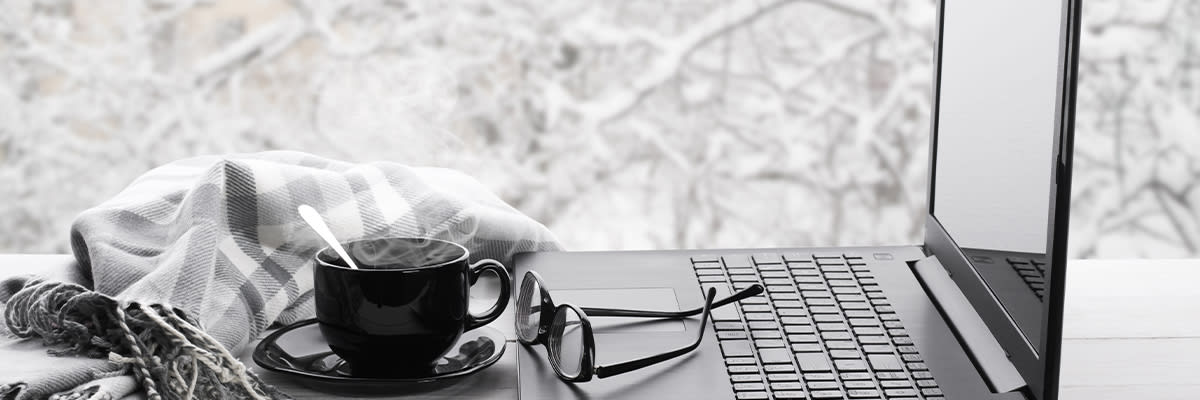
Return navigate_next
How to Protect Your Laptop From Cold Weather
January 3, 2022 *
Severe winter chills can be alarming for anyone spending time outdoors, but they’re even more lethal for the technology we hold dear. From cold temperatures draining batteries to moisture wreaking havoc on internal components, it’s important to know the dangers of winter weather and how they can be addressed.
Laptops, in particular, are susceptible to damage. Often, they must endure the rigors of travel, not to mention the general wear and tear of everyday use. However, unlike smartphones, they’re frequently left unattended in bags or on their own, while other mobile devices remain on our person. As such, laptops require extra protection.
Worried about keeping laptops safe as cold weather takes over? These cold weather laptop tips should help:
Never Leave a Laptop in a Cold Vehicle Overnight
Regardless of the season, it’s never wise to leave valuables such as laptops in a car. It’s an especially bad idea in the winter when cold temperatures can put the deep freeze on a laptop in no time at all.

Even with the protection of a laptop bag or backpack, the cold winter air will make its way into every nook and cranny of any electronic device. While it may be tough to juggle groceries, children, and a laptop bag while coming in from the cold, doing so can limit the likelihood of suffering irreparable damage.
Don’t Use Your Laptop in Cold Temperatures
While it’s tempting to use a laptop in an ice fishing house, a drafty attic hideout, or while enjoying a hot beverage on the deck, it’s not a good idea. As previously mentioned, few things drain a lithium-ion battery faster than cold temperatures.
Not sure what is considered cold enough to damage a battery? Most experts agree that 40 degrees Fahrenheit is the breaking point when batteries degrade due to the cold. Where would it even be possible to use a laptop comfortably in such conditions? Unheated garages, attic spaces, or three-season porches can commonly drop below 40 degrees during the winter. Avoid these locations and keep laptops indoors instead.
Use a Waterproof Laptop Bag
A waterproof laptop bag can protect beloved devices all year long. The same bag that guards against rain in the spring and summer can help keep out moisture from the snow during the winter.

However, these bags aren’t perfect, and leaving one in a snowbank or on the deck during a snowstorm will eventually allow moisture to find its way in.
Be Mindful of Surfaces
Excessive cold is by no means the only winter threat that plagues laptops. Believe it or not, these devices are also prone to overheating during the winter months.
Laptops overheat when the cooling vents on the bottom of the device become blocked or obstructed. Often, the surfaces on which they’re used are to blame. Fluffy, heavy blankets, for example, can block vents. Users who feel a little too toasty while using their laptop under the blankets should place their device on flat, smooth surfaces instead.
Allow Time for the Cold Laptop to Warm Up Gradually
Sometimes, there’s no choice but to use a laptop in a chilly room during the winter. If this is necessary, give the device time to warm up before using it. In most situations, five minutes should do the trick.
Another essential? Avoid bringing a laptop from a very warm room into a colder area. This change in temperature could create moisture inside the laptop, which is the ultimate enemy of electronic devices.

Protect Laptops Year-Round With Upsie Extended Warranties
Regardless of the season, Upsie provides the best protection for laptops. Upsie’s warranties ensure that customers have access to fast repairs or replacements. In addition, Upsie is affordable and often costs up to 70 percent less than warranties from retailers or manufacturers. Best of all, customers can make unlimited claims up to the purchase price of the device, ensuring that they get the most out of every claim.
Upsie offers exceptional warranties for a variety of beloved laptops, delivering the protection and peace of mind that customers deserve.
Learn More About Laptops:
* This article is over 6 months old and may or may not be updated.
